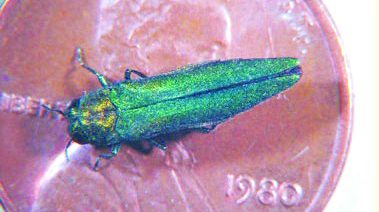JUSTIN MALLETT
Arkansas Foresty Commission
It’s amazing that just a little bug can do as much damage as the Emerald Ash Borer has done. If you have followed the news since 2002 you might have heard of it. The insect we are talking about is only a ¼ to ½ inch in length as an adult. The insect gets its name because it’s emerald green and attacks ash. The beetle is native to Asia and was first found in the US in 2002 in Michigan. In late 2014, the EAB was discovered in Arkansas.
The life cycle of the adult female starts with laying eggs on the bark, which hatch and the larva chew into the bark. The larva feed in this area for several weeks destroying the part of the tree that transfers water and nutrients in the tree. After the larva complete their larval cycle and pupates. They appear as adults; leaving the tree with a D-shaped exit hole in the bark.
According to the Forest Service Forest Inventory and Analysis, ash trees comprise a little more than 2.6% of the trees in Arkansas. While not a large percentage of the trees in Arkansas this tree is still important to the state. Ash is also a popular horticultural tree that has been planted in many yards and is known for its shade.
Identification is first dependent on the type of tree, as it has only been found in ash trees. If you think you have a tree that is being damaged please make sure that the tree is an ash. Ash can be identified as a tree that has opposite, pinnately compound leaves that are 8 to 12 inches long. The limbs of the tree will emerge from the branches and the tree across from each other, also known as opposite of each other.
Most times we will not actually see the beetle itself but will be able to identify the problem by the damage. Here are some of the symptoms:
• Overall decline of the tree from the top down.
• Limb sprouts from the tree on the trunk signifying the trees attempt to survive.
• D-shaped holes in the bark from where the adults emerge.
• S-shaped galleries under the bark of the tree.
The Arkansas Plant Board and other contributing state organizations and cooperators are working together to survey the areas that have the Emerald Ash Borer. A quarantined area has been designated by the Arkansas Plant Board. This area shows which counties have emerald ash borer as well as providing a buffer zone around these areas to slow the spread. Howard County is included in the quarantined counties as well as Garland, Hempstead, Little River, Montgomery, Sevier and Pike counties.
One of the best ways to prevent EAB from spreading is to use local firewood only. It is believed that the moving of firewood is possibly the cause of the introduction to Arkansas. It is important not take ash out of these areas. You may find more information, such as how to identify an ash tree and what the emerald ash borer looks like from the link below.
To view the quarantined areas please use this link to access our website as well. http://forestry.arkansas.gov/Services/ManageYourForests/Pages/EmeraldAshBorer(EAB).aspx).
If you feel like you may have the emerald ash borer please contact your local Arkansas Forestry Commission at (870) 286-2137 or the Cooperative Extension Service at (870) 845-7517.
The Arkansas Forestry Commission offers its programs to all eligible persons regardless of race, color, national origin, sex, age or disability and is an Equal Opportunity Employer.





